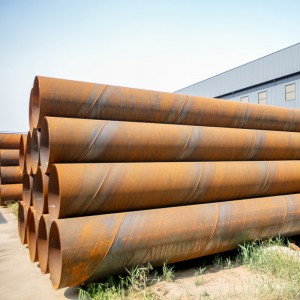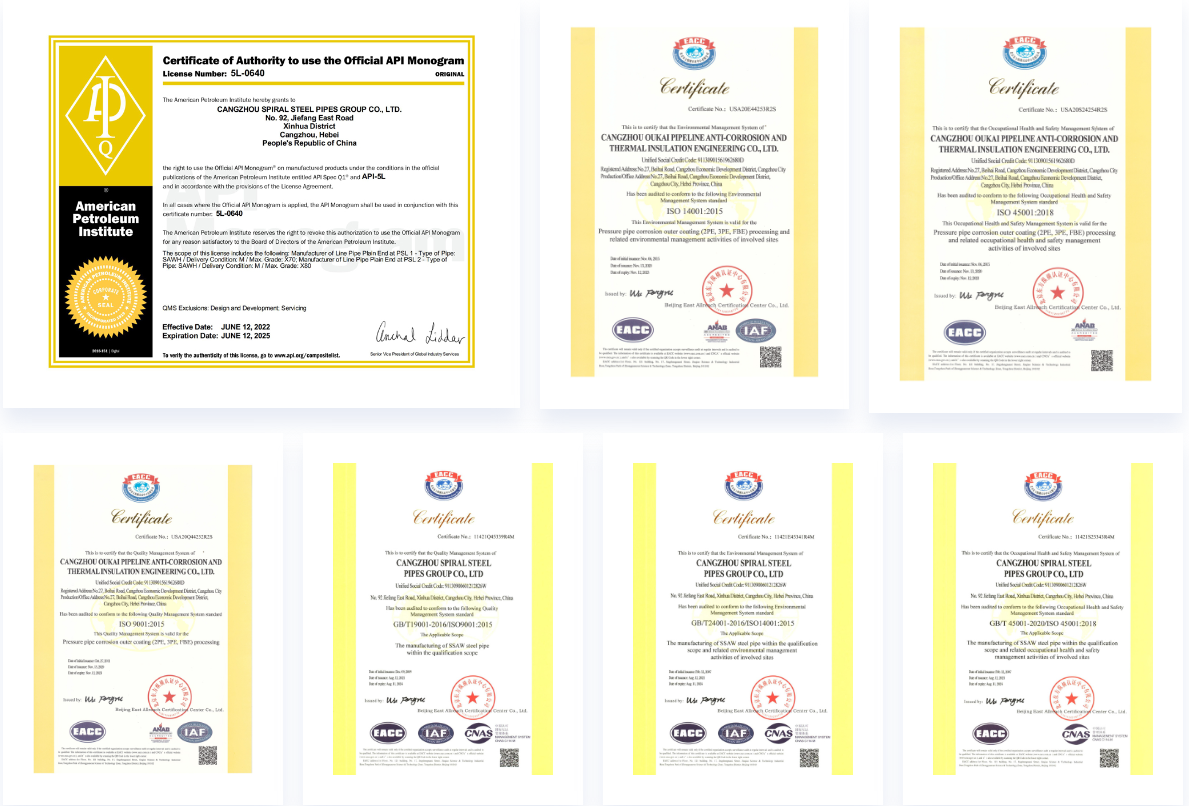Enhancing Structural Integrity: Spiral Welded Carbon Steel Pipe in Metal Pipe Welding Process
Introduce
The art of metal pipe welding requires a harmonious combination of skill, precision and quality materials to ensure structural integrity for a variety of applications. Among the many types of pipe, spiral welded carbon steel pipe, such as X42 SSAW pipe, is popular for its superior strength, durability and cost-effectiveness. In this blog, we will explore the significance of spirally welded carbon steel pipes in the metal pipe welding process, delving into its manufacturing process, advantages and application areas.
Mechanical Property
| steel grade | minimum yield strength | Tensile strength | Minimum elongation | Minimum impact energy | ||||
| Mpa | % | J | ||||||
| Specified thickness | Specified thickness | Specified thickness | at test temperature of | |||||
| mm | mm | mm | ||||||
| <16 | >16≤40 | <3 | ≥3≤40 | ≤40 | -20℃ | 0℃ | 20℃ | |
| S235JRH | 235 | 225 | 360-510 | 360-510 | 24 | - | - | 27 |
| S275J0H | 275 | 265 | 430-580 | 410-560 | 20 | - | 27 | - |
| S275J2H | 27 | - | - | |||||
| S355J0H | 365 | 345 | 510-680 | 470-630 | 20 | - | 27 | - |
| S355J2H | 27 | - | - | |||||
| S355K2H | 40 | - | - | |||||
Chemical Composition
| Steel grade | Type of de-oxidation a | % by mass, maximum | ||||||
| Steel name | Steel number | C | C | Si | Mn | P | S | Nb |
| S235JRH | 1.0039 | FF | 0,17 | — | 1,40 | 0,040 | 0,040 | 0.009 |
| S275J0H | 1.0149 | FF | 0,20 | — | 1,50 | 0,035 | 0,035 | 0,009 |
| S275J2H | 1.0138 | FF | 0,20 | — | 1,50 | 0,030 | 0,030 | — |
| S355J0H | 1.0547 | FF | 0,22 | 0,55 | 1,60 | 0,035 | 0,035 | 0,009 |
| S355J2H | 1.0576 | FF | 0,22 | 0,55 | 1,60 | 0,030 | 0,030 | — |
| S355K2H | 1.0512 | FF | 0,22 | 0,55 | 1,60 | 0,030 | 0,030 | — |
| a. The deoxidation method is designated as follows: | ||||||||
| FF: Fully killed steel containing nitrogen binding elements in amounts sufficient to bind available nitrogen (e.g. min. 0,020 % total Al or 0,015 % soluble Al). | ||||||||
| b. The maximum value for nitrogen does not apply if the chemical composition shows a minimum total Al content of 0,020 % with a minimum Al/N ratio of 2:1, or if sufficient other N-binding elements are present. The N-binding elements shall be recorded in the Inspection Document. | ||||||||
Manufacturing process
Spiral welded pipe, also known as SSAW (spiral submerged arc welded) pipe, is manufactured using spiral forming and submerged arc welding techniques. The process begins with edge treatment of the coiled steel strip and then bends the strip into a spiral shape. Automatic submerged arc welding is then used to join the edges of the strips together, creating a continuous weld along the length of the pipe. This method ensures that the joint is strong and durable while minimizing defects and maintaining structural integrity.
Advantages of spiral welded carbon steel pipe
1. Strength and durability: Spiral welded carbon steel pipe is known for its superior strength and durability, making it suitable for applications requiring high pressure resistance and long-term performance.
2. Cost-Effectiveness: These pipes offer a cost-effective solution due to their efficient manufacturing process, lower raw material costs, and reduced labor requirements compared to other types of pipes.
3. Versatility: The versatility of spiral welded carbon steel pipe allows it to be used in a wide range of applications, including water transportation, oil and gas transportation, piling structures, sewage systems, and various industrial processes.
4. Dimensional accuracy: The spiral forming process can accurately control the size and wall thickness of the pipe, ensuring the accuracy and uniformity of production.
Application areas
1. Oil and natural gas industry: Spiral welded carbon steel pipes are widely used in the oil and natural gas industry, especially in the transportation of crude oil, natural gas and petroleum products. Their strength and ability to withstand high-pressure environments make them ideal for long-distance pipelines.
2. Water Transmission: Whether for municipal water supply or irrigation purposes, spiral welded carbon steel pipes provide an excellent solution due to their corrosion resistance, strength and ease of installation.
3. Structural support: This type of pipe is widely used in the construction industry to provide structural support for buildings, bridges, docks and other infrastructure projects. Their durability and resistance to external elements make them reliable in such applications.
4. Industrial Applications: Spiral welded carbon steel pipes are used in various industrial fields such as chemical processing, power plants and mining operations due to their ability to handle high temperatures, pressures and corrosive environments.
In conclusion
Spiral welded carbon steel pipe, such as X42 SSAW pipe, has revolutionized the metal pipe welding process, bringing many benefits to different industries. Their strength, durability, cost-effectiveness and dimensional accuracy ensure structural integrity in a variety of applications. The ability to withstand extreme pressures, temperatures and corrosive environments makes it ideal for oil and gas transmission, water supply and other industrial sectors. Therefore, when it comes to metal pipe welding, the use of spiral welded carbon steel pipes remains a reliable and efficient solution to ensure long-lasting and resilient infrastructure.
Hydrostatic Test
Each length of pipe shall be tested by the manufacturer to a hydrostatic pressure that will produce in the pipe wall a stress of not less than 60% of the specified minimum yield strength at room temperature. The pressure shall be determined by the following equation:
P=2St/D
Permissible Variations In Weights and Dimensions
Each length of pipe shall be weighed separately and its weight shall not vary more than 10% over or 5.5% under its theoretical weight, calculated using its length and its weight per unit length
The outside diameter shall not vary more than ±1% from the specified nominal outside diameter
Wall thickness at any point shall not more than 12.5% under the specified wall thickness








